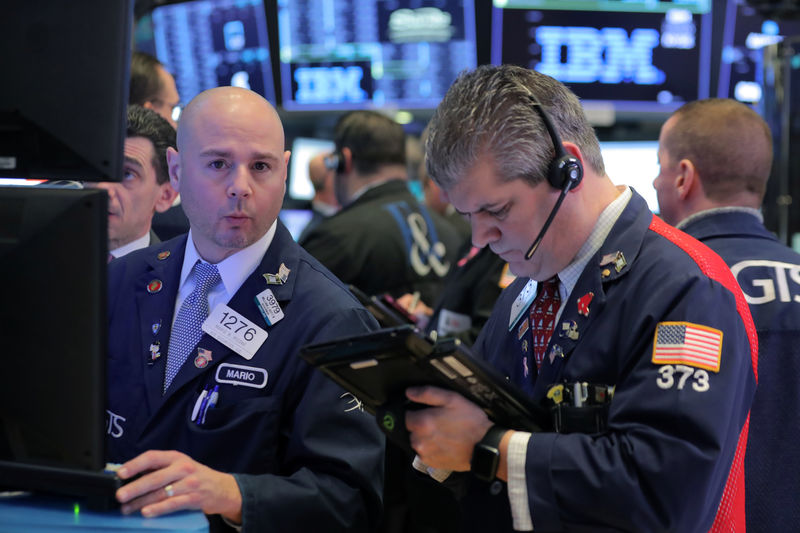By Sinéad Carew
NEW YORK (Reuters) - U.S. companies' shopping spree for their own shares helped put a floor on market declines in 2018. Don't look for the same level of support in 2019.
Wall Street's recent volatility has optimists betting that buybacks could provide the market with an even better buffer in 2019. But many strategists see the lift from buybacks - a major factor behind the bull market - losing some force as earnings growth slows while tax policy bonanzas fizzle out.
"Companies bought back around 2.8 percent of shares outstanding in 2018. That was a substantial support to the market and bigger than dividends," said Jack Ablin, chief investment officer at Cresset Wealth Advisors in Chicago.
"(In 2019) we expect the corporate firepower behind share buybacks to be diminished. The growth in cash flow will be slower."
Last year will likely go in the books as a record for buybacks. Through the first three quarters of the year companies bought $583.4 billion of their own stock, just shy of 2007's full-year record of $589.1 billion, according to S&P Dow Jones Indices data.
But even that was insufficient to prevent 2018 ending with a resounding thud for U.S. stocks as the S&P 500 (SPX) tumbled nearly 20 percent from its late-September high, although it probably prevented losses from being even deeper. For the year, the index fell 6.2 percent, its poorest showing in a decade.
(GRAPHIC: U.S. cash repatriation trends - https://tmsnrt.rs/2SaiAWb)
FOREIGN PROFIT REPATRIATION SLOWS
Strategists say U.S. companies will spend heavily again on their own shares in 2019 as they have plenty of cash and tend to favor buybacks over dividends and major capital investments in times of economic and policy uncertainty.
Goldman Sachs (NYSE:GS) has forecast a 44 percent jump in buybacks to $770 billion for 2018, with growth slowing to a 22 percent rise to $940 billion for 2019.
But the market clout from buybacks will likely dwindle without the cash boost from a 2018 tax break on earnings brought home from overseas and the slashing of corporate tax rates.
After rushing home some $295 billion of foreign profits in the first quarter of 2018, the pace of repatriation by U.S. multinationals has since slowed sharply, Commerce Department data shows. In the third quarter that was down to about $93 billion.
About $190 billion, or about a third, of repatriated funds were used on buybacks in the first three quarters of 2018, JPMorgan (NYSE:JPM) strategist Nikolaos Panigirtzoglou wrote. But if repatriation keeps decelerating the buyback boost will dissipate, he said.
Slower 2019 buyback growth would be partly due to a difficult earnings comparison with 2018, when Republicans cut corporate tax rates. Wall Street is expecting S&P 500 earnings growth of 6.7 percent in 2019, down from estimates for 23.5 percent growth in 2018, according to Refinitiv's IBES.
Any resolution to U.S.-China trade tensions might also weigh on buybacks.
The uncertainty generated by the dispute made companies more comfortable using surplus cash on buybacks rather than new capital investments. Chris Zaccarelli, Chief Investment Officer, Independent Advisor Alliance in Charlotte, North Carolina, expects that to continue until a deal is reached.
After that happens, the emphasis could switch to capital spending, he said.
(GRAPHIC: History of S&P gains and retreats with buyback trends - https://tmsnrt.rs/2SbIngu)
FEEDING THE BULL
Buybacks have been a major support to the bull market that began in March 2009. S&P 500 companies bought roughly $4.5 trillion worth of their own shares, equal to about a third of the benchmark's $15 trillion gain in value over that time, according to Audrey Kaplan, head of global equity strategy at Wells Fargo (NYSE:WFC) in New York.
Kaplan expects 2019 spending on buybacks to stall around 2018 levels as companies weigh slower earnings growth against strong cash balances. But the sharp fall in stock prices in late 2018 means companies can buy more shares.
"Corporate managers should find share prices attractive at these levels," she said.
Datatrek Research said U.S. companies tend to spend between 40 percent and 60 percent of operating income on buybacks and only breach the low end in "the direst times."
So even if earnings were to decline, buybacks would not disappear but would fall at the same rate as earnings, according to Datatrek Research co-founder Nicholas Colas.
"The amount of buybacks hasn't peaked but the growth in buybacks perhaps has peaked," said Burns McKinney, a portfolio manager at Allianz (DE:ALVG) Global Investors in Dallas. "You just won't have the same amount of tailwind."
